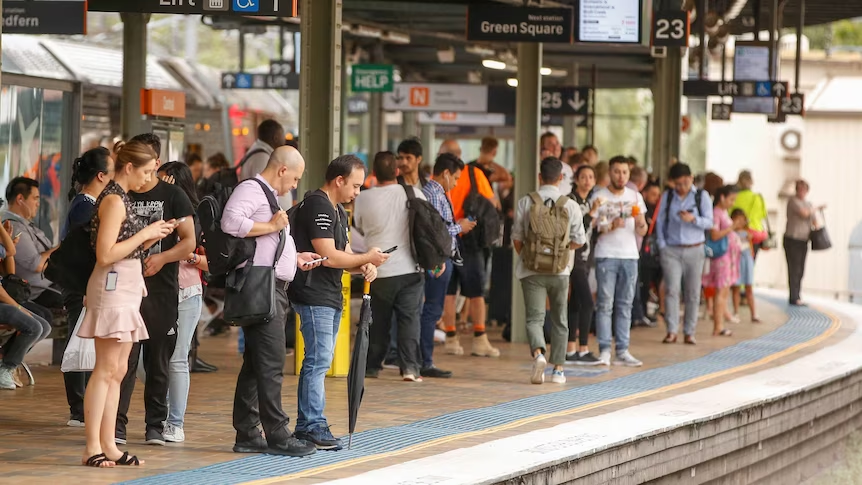The average Australian worker spends more than an hour a day stuck in rush-hour traffic, fighting for a seat on the bus or trying to zone out on the train.
Commute times nationwide are longer than for many European countries — they also surpass other car-dependent countries such as the United States.
But is there a reason we’re lagging behind? And what can we do to make our travel time shorter?
Are commuter times likely to get better soon?
It’s all relative but commuter times in Australia have been increasing.
For example, workers averaged a weekly commuting time of about 3.7 hours just more than two decades ago. That grew to about 4.5 hours in 2017.
Dr Alan Both from the Australian Urban Observatory said the urban sprawl in some of the larger cities including Melbourne and Sydney was contributing to the increase in commuter travel time.
“It’s quite normal for people to be living over an hour away from work,” he said.
“Affordability is the main issue with these sorts of things — you can’t expect young professionals to be able to afford anywhere near the city, they just simply have to live further out.
“And because of that, they have the experience of longer commutes.”
Dr Both explained there were solutions to ease the traffic and add more public transport in newly built suburbs in some of the country’s growth areas.
“One of the last things to go in are things like bus stops. So in general, if you’re moving to a new area, you are a car user,” he said.
“So you have to drive and that increases the traffic on the roads and slows everything down.”
He added that due to the heavy reliance on car usage and a lack of public transport options in some of these newly built outer suburbs, delays in getting to work were inevitable.
“New suburbs have really bad congestion. You even see it in the sort of middle- and outer-ring suburbs where just getting onto the highway is a traffic jam,” he said.
“So not even actually getting to the highway just, you know, entering and exiting.”
RMIT University’s Dr Koorosh Gharehbaghi specialises in public transport systems.
He said the average distance people were living away from work was increasing but there were other factors at play.
“In cities that are doing sort of a large upgrade with the Sydney Metro, even Melbourne, for example, the commuter time has increased because they’re doing a lot of maintenance works and upgrades,” he said.
“But what it comes down to is the actual distance of travel to work.”
How does Australia compare to other parts of the world?
Australia does not compare well to international examples in both Europe and North America.
In Europe, more than 60 per cent of workers in the EU travelled less than half an hour from work to home.
But experts including Dr Gharehbaghi have said European examples might not be the best comparison when it comes to Australia.
For example, cities such as Copenhagen were smaller in size and population.
But Dr Gharehbaghi said there were elements like frequency of service that Australia could try to emulate.
“The level of public transport service they have … are not only the latest systems available, but the frequency that they have with their public transport is quite high,” he said.
What are some international examples that Australia could look to?
Experts have said Australia should look at cities that have a comparable size with similar levels of urban sprawl of large capitals including Melbourne and Sydney.
“In smaller cities and countries, they have much more [stricter] sort of planning schemes, which means they heavily monitor due to lack of available land,” he said.
It’s why he thinks some of Australia’s largest cities should look to Toronto for models to improve commuter travel.
“What you find with Toronto, is it has a lesser commuter wait time compared to Melbourne,” he said.
“Why that is, because they’re spending a lot of money on upgrading and updating the systems, more than the state government of Victoria, as well as the federal government.”
What can governments do to improve work commute times?
The frequency of public transport services is top of the list for both experts but they say there needs to be more foresight in planning our cities.
“Increasing frequency is one but also in making sure that, again, that the system can be able to handle that higher-intensity service required,” Dr Gharehbaghi said.
He believes a bigger problem for increased commuter times, especially in some of the larger capital cities, is unchecked growth in some outer-suburban communities.
“We have urban growth corridors that are designated by the state governments in terms of the population sort of growth for the future,” he said.
“But what happens is, when the population of cities are expanding, [they are] not in the particular area that the government had in place in terms of possible growth.”
Dr Both explained there were several things in play, including increased frequency of services and higher density.
But he said there were some quick wins governments could have in improving commuter times.
“One of the big barriers for people using the transit system is inflexibility. You quickly become beholden to the schedule of the public transit,” he said.
He added there might be difficulty in increasing services on trains in the short term but said there was an opportunity to strengthen the bus network.
“If you go to the outer suburbs or even middle-ring suburbs, there might be a bus only every 30 minutes,” he said.
“If you’ve just missed that bus, you’re waiting there for another 30 minutes.”
ABC News
